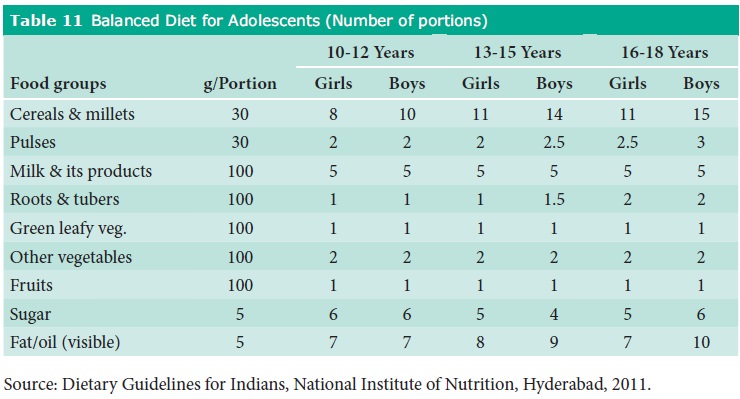Chapter: 11th Home Science : Chapter 6 : Family Meal Management
Nutritional Requirements During Adolescence
NUTRITIONAL REQUIREMENTS DURING ADOLESCENCE
Adolescents is the period between
child-hood and adulthood. It is a period of rapid growth after infancy and it
reaches its peak between 11th to 14th years for girls and
13th to 16th years for boys. Adolescence require more
food for the following reasons:
a. this
period (teenage) is spread almost
over a decade,
b. it is characterized by rapid increase in height and
weight, hormonal changes, sexual maturation and wide swings in emotion,
c. development of critical bone mass is essential during
this period as this forms the ground for maintain-ing mineral integrity of the
bone in later life,
d. the pattern and proportion of var-ious body components
like body water, muscle mass, bone and fat increase during the entire
child-hood and adolescence to reach adult values by about 18 years.
Adolescent girls are at greater physiological stress than
boys because of menstruation. Their nutritional needs are of particular
importance as they have to prepare for motherhood.
Nutritional Needs of Adolescents
Good nutrition is critical during the teen-age years to
ensure healthy growth and development. A healthy diet must meet the changing
nutritional needs of a grow-ing teenager.
Energy
Calorie needs is influenced by activ-ity level, basal
metabolic rate, increased requirements to support pubertal growth, development
and energy expenditure. The energy requirements for boys are more than that of
girls.
Protein
Protein needs of adolescents are influ-enced by the amount
of protein required for maintenance of existing lean body mass and accrual of
additional lean body mass during the adolescent growth spurt. When protein
intakes are consistently inadequate, reductions in linear growth, delays in
sexual maturation and reduced accumulation of lean body mass may be seen.
Fat and Essential Fatty Acids
The human body requires dietary fat and essential fatty
acids for normal growth and development. The intakes of total fat and saturated
fat should not exceed RDA.
Calcium
Calcium needs during adolescence are greater than they are
in either childhood or adulthood because of the dramatic increase in skeletal
growth. Milk provides the greatest amount of calcium in the diets of
adolescents.Ragi, green leafy vegeta-bles, milk and milk products are excellent
sources of calcium.
Iron
Iron is vital for transporting oxygen in the bloodstream
and for preventing anaemia. For both male and female adolescents, the need for
iron increases with rapid growth and the expansion of blood volume and muscle
mass. The onset of menstruation imposes additional iron needs for girls.
Zinc
Zinc is important in adolescence because of its role in
growth and sexual matura-tion. Males who are zinc deficient expe-rience growth
failure and delayed sexual development.
Vitamins
Vitamin A is important for normal vision and plays a vital
role in reproduction, growth, and immune function. The most obvious symptom of
inadequate vitamin A consumption is vision impairment, espe-cially night
blindness. The low intake of fruits, vegetables and milk and dairy prod-ucts by
adolescents contributes to their less than optimal intake of vitamin A.
Vitamin E is well known for its anti-oxidant properties,
which become increas-ingly important as body mass expands dur-ing adolescence.
Fortified breakfast cereals and nuts are good sources of vitamin E. Vitamin C
is involved in the synthesis of collagen and other connective tissues
Fibre
Dietary fibre is important for
normal bowel function, and plays a role in the prevention of chronic diseases,
such as certain cancers, coronary artery disease, and type 2 diabe-tes mellitus
and reduces the risk of obe-sity. Increased intake of fruit, vegetables, and
whole grains increases the fibre intake. Adolescents who skip breakfast or do
not routinely consume whole grain cereals are at high risk for having an
inadequate con-sumption of fibre.

Dietary Guidelines for Adolescents
Diet in adolescents is very significant because it
influences the nutritional status later in life.
– Adequate well balanced nutritious food should be taken
to prevent obesity or under nutrition.
– An adolescent girl should take enough calcium rich foods
in her diet to increase bone density and delay the onset of osteoporosis.
– Should not miss
breakfast.
– Junk food should
be avoided.
– Avoid empty calorie foods such as carbonated beverages.
– Iron rich foods may be included in the diet to prevent
anaemia.
– Calorie and protein rich foods should be taken to
support the growth spurt.
– Include fruits and vegetables in
the diet to meet the vitamin, mineral and fibre requirement.
– Home based diets are best for chil-dren’s growth.
– Adolescents need to be
encouraged to do physical activity particularly outdoor games. Physical
activity regulates appetite.
Nutrition Related Problems
·
Acne
Vulgaris
·
Anaemia
·
Obesity
·
Eating
Disorders
a.
Anorexia
Nervosa
b.
Bulimia
Nervosa
c.
Binge
Eating Disorder
·
Predisposition
to Osteoporosis
Related Topics